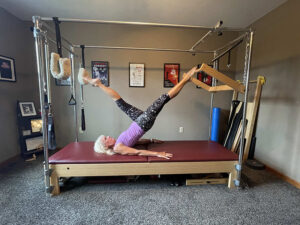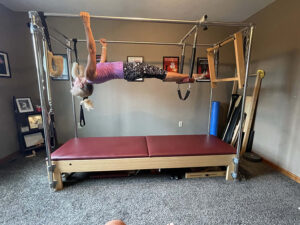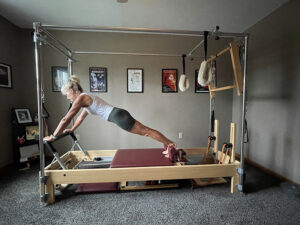Growing in popularity, the practice can help keep you limber and strong
By Deborah Jeanne Sergeant

Popular through studios, videos and online, Pilates provides a system of strength training that helps participants gain muscle and recover from injuries or surgery.
In fact, Joseph Pilates developed the practice in the early 1900s to help bedridden patients develop better strength through breathing exercises and by using springs affixed to their hospital beds.
That rudimentary apparatus became the Pilates Reformer, equipment that current practitioners use.
Numerous styles of Pilates have developed since its founder introduced it.
“Pilates is similar to functional resistance training,” said Ashley Capenos, nationally certified Pilates trainer at Metro Fitness Downtown in Syracuse. “We use springs instead of weights. It’s balanced with your intrinsic and extrinsic muscular systems. It’s focused on the core, but that helps stabilize all other parts of your body.
 “The equipment can cater to whatever the body’s level or person’s goal, whether it’s someone who’s a Division 1 college athlete in their prime or someone off a double hip replacement. Their workouts will look different, but they can benefit from Pilates as a whole.”
“The equipment can cater to whatever the body’s level or person’s goal, whether it’s someone who’s a Division 1 college athlete in their prime or someone off a double hip replacement. Their workouts will look different, but they can benefit from Pilates as a whole.”
Working with a certified instructor one-on-one can help modify Pilates movements to accommodate injuries.
Valerie Patrick, owner and teacher for about 30 years at Core Pilates & Yoga in Cicero, considers Pilates a mind-body exercise, breathing-based, and focused on stretching and strengthening. In those aspects, it’s similar to yoga, but “Pilates works more on core stability and strength.”
“A lot of people think it’s only for dancers,” she added.
 Because Joseph Pilates’ studio was located near a dance school, many dancers came to him to help them recover from injuries. This early association has caused many people to think that Pilates is a “woman’s activity,” stereotype with which Patrick disagrees.
Because Joseph Pilates’ studio was located near a dance school, many dancers came to him to help them recover from injuries. This early association has caused many people to think that Pilates is a “woman’s activity,” stereotype with which Patrick disagrees.
“It was developed by a man, for men,” she said. “Joseph Pilates worked with the British Army to rehab soldiers.”
Much of the equipment used in Pilates is proprietary, such as the Reformer. There’s also the “Cadillac” (also known as the trapeze table).
The raised mat — complete with a framework, springs and other apparatuses — allows instructors to not have to get down on the floor with each student to adjust and correct them. The apparatuses aid students who need to improve their physical condition and resistance to challenge them. Students perform movements on an exercise mat also.
Patrick said that practicing Pilates helped with her congenital back condition.
“I took Advil every day for the pain,” she said. “Once I started doing Pilates, it was the only thing that helped me and I now live pain-free. I have had many students who came to me with different health conditions. I’ve seen so many success stories from those students due to the benefits of Pilates.”
One way in which Pilates is different from other types of exercise is that it works small, connective tissues are often overlooked with other activities. Pilates also builds range of motion within the joint itself, which is different and more difficult that stretching before a workout.
By strengthening the core, Pilates helps people improve in many types of athletic pursuits.
“Pilates is known to be a great way to build core strength,” said Jill Murphy, certified personal trainer and co-owner of Mission Fitness in Syracuse.
She added that Pilates also helps build overall stability.
“Pilates challenges people physically in ways that other exercise does not, and also helps increase flexibility,” Murphy said. “Although some may use it to try to build strength, proper resistance training would be superior to building muscle the most efficient and effective way possible.”
This may include athletes who want to improve to people recovering from surgery, sedentary lifestyle or an injury. And in any case, Murphy believes that Pilates improves mobility for supporting day-to-day activities.
